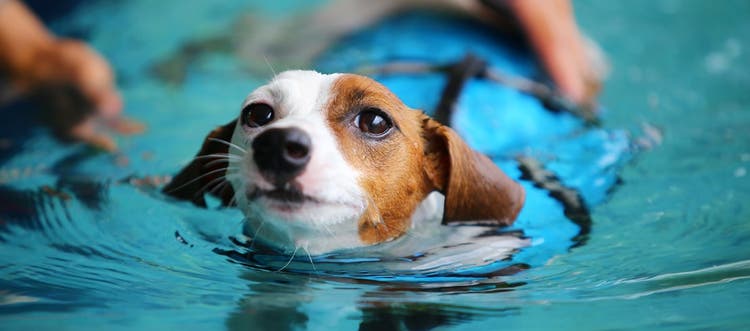Plus dog-friendly vacation ideas.
The summertime is an especially great season to get outside. If you and your dog want to venture into the heat this year, here is your ultimate guide to a safe, dog-friendly summer.
How Hot Is Too Hot for Dogs?
According to the American Kennel Club (AKC), if the temperature hits 85 F and stays elevated all day long, you should keep your dog inside. This advice is largely to protect your dog’s paws from hot surfaces, like sidewalks or roads, as they walk.1 Heatstroke can also occur on hot summers days, especially when the weather is humid. Let’s take a closer look at hot-weather safety tips for your pet.
When Is It Too Hot to Walk a Dog?
According to the AKC, when the air temperature is 86 F, the asphalt temperature can register at 135 F, which can burn your dog’s paws. Wondering if the ground outside is too hot? Test it with your own bare foot or hand for at least 10 seconds. If it’s too hot for you, it’s too hot for your pet.1
Remember: Most dogs have fur coats that hold in heat, so they are more sensitive to warm temperatures than we are. Some dogs might be willing to wear dog shoes, but finding ones that fit well can be challenging and not all dogs like them.
Walking with your dog outside in hot weather can also increase your dog’s body temperature. Dogs can cool themselves off by panting and blood vessel expansion — but that’s about it.2 Heat stress occurs when your dog’s temperature is over 104 F; heat exhaustion occurs when your dog’s temperature is over 105 F. If your dog’s temperature is over 106 F, that may signify heatstroke, and it’s important to seek emergency veterinary care right away.1
Signs of Heatstroke in Dogs and What to Do
Your dog has a fever when their temperature is above 101.5 F. They may be experiencing heatstroke if their temperature is above 105 F.2
Many different factors can contribute to heatstroke, including your dog’s breed (all breeds are susceptible, some more so than others), weight (overweight and obese dogs are more at risk), age (think very young and older dogs), and average activity level. Medical disorders and how much water your dog has had to drink throughout the day can also contribute to heatstroke. Sometimes a sudden change to a hot temperature can play a role, too.2 Also, it’s not just about the temperature outside — according to the Humane Society, high humidity can lead to excess moisture in the lungs, which your dog may not be able to control through normal panting.3
Signs of heatstroke can include:
- Heavy panting
- Excessive drooling
- Glazed eyes
- Increased heartbeat
Check your dog’s gums and tongue — if they’re bright red, that’s a sign they are overheating. Your dog’s skin also may feel hot. Without treatment your dog may show signs of shock. The heart rate will continue to increase, the gums may look white or blue, and your dog may have trouble breathing. Vomiting and diarrhea may occur. Your dog may have a seizure, become lethargic or lose consciousness.2,3,4
While these signs sound scary, there are several steps you can take to cool your dog down if you suspect heatstroke. First, stop all activity. You will need to get to a vet as soon as possible. Walk (or, if you can, carry) your dog to a cool, shady and ventilated area. Depending on the severity of the situation, you may need to cool your dog down. If you have ice packs handy, press those against your dog’s chest. Pour tepid water over your dog’s head and body, and give your dog a small amount of water to drink.
If you have a rectal thermometer, take your dog’s temperature. According to the AKC, if the temperature is lower than 105 F, take your dog to a vet immediately. If it’s higher than 105° F, cool their temperature down first, but only to 103 F, and then immediately take your dog to a vet. This is something you can’t treat at home as your dog will likely require IV fluids, oxygen, medication, bloodwork and 24/7 monitoring.1,2,4
How to Keep Dogs Cool in the Summer
Dogs can overheat quickly in hot, humid temperatures. Here are some ways to keep cool on typical hot summer days:
- Never leave your dog inside a parked car. According to the Humane Society, on an 85 F day, the temperature inside a car — even with the windows opened slightly — can reach 102 F in 10 minutes.3
- Keep your dog inside on hot days. If you have air conditioning, set it no higher than 80 F.4 If you don’t have air conditioning, shut all the blinds and leave fans on during the day. Ceiling fans are the safest option and provide the best airflow.4
- If you and your dog plan on being outside, provide lots of shade (bring an umbrella if shade won’t be available), clean water and a bowl. When possible, bring a cooler and pack ice-pop treats made especially for dogs — you can find them at your grocery or pet supply store, or look online for a recipe to make them.
- If you have a long-haired dog, consider a trim at the groomer’s and limit their exercise on hot days. You might also look into dog-cooling vests or cooling mats — just be sure to research, read reviews and follow the instructions when using them.
Can I Give My Dog Ice Cream?
Unfortunately, no, you should not give your dog ice cream. According to the AKC, many dogs are lactose intolerant and may have food allergies. Some ice cream flavors (such as chocolate) can be toxic to dogs. Eating ice cream can also contribute to obesity.
But just because your dog can’t eat ice cream doesn’t mean your pal has to miss out on cold summertime treats! Many grocery and pet supply stores sell dog-friendly sweet freezer treats. Additionally, if you search for “dog-friendly ice cream” online, you’ll find lots of easy recipes.
How to Keep a Dog Safe in the Water
Dogs can have a blast playing in water, whether it’s an ocean, lake or pool. No matter what kind of body of water you plan on taking your dog to, follow these general tips:
- Research which beaches, lakes and pools in your area allow dogs, if there are day and time restrictions, and if leash laws are enforced.
- Make sure your dog knows basic commands (e.g., sit, stay, come).
- Be mindful of the temperature and your dog’s paws. If the sand, dock, concrete patio or any other outdoor surface is too hot for your bare feet, it’s too hot for your dog’s paws.
- Consider using pet-safe sunscreen (yes, this exists!).
- Check your dog’s flea collar — you may need to remove it so the water won’t wash off its active ingredients.
- Bring lots of clean water to keep your dog hydrated.
- Don’t let your dog drink the salt water, lake water or pool water.
- Rinse your dog off after they exit the water, and dry your dog’s ears well.
- Teach your dog to swim.
- Consider bringing a dog life jacket with a handle.
- Never leave your dog unattended in or near the water.6,7
Here are some more ways to keep your dog safe when you’re around specific bodies of water:
How to Keep a Dog Safe at the Beach
- Don’t let your dog eat the sand.
- Be mindful of water conditions. Public beaches often post daily flags letting patrons know the water condition status. If a lifeguard is present, you can also ask them.
- Make sure your dog isn’t too curious about sea creatures like crabs and jellyfish.6
How to Keep a Dog Safe at the Lake
- Keep your dog away from fishing gear or lines where people are fishing.
- When on a boat, keep your dog on a leash when the boat is moving. Be sure your dog is wearing the appropriate life vest, too.
- Consider adding some carpet or rubber matting to the boat to help keep your dog from slipping.
- Look for blue-green algae, which can be toxic. It’s often found in stagnant freshwater during hot weather, and can be blue, green, brown or red.
How to Keep a Dog Safe at the Pool
- If you have a pool at home, put a fence around it that your dog can’t breach.
- Teach your dog how to get in and out of the pool. Steps or even a ramp can help.
- Always supervise your dog when they have access to the pool.
- Check the water temperature — not all dogs can handle very cold water. If you’re cold in the water, it’s probably safe to say your dog is, too.
- If you own a pool, invest in a high-quality pool cover that doesn’t collect puddles on top of it — those puddles can be drowning hazards.7
Great Dog-friendly Vacation Ideas
Choosing a dog-friendly destination can be helpful when taking your dog on vacation. As noted above, many beaches, lakes and even pools allow dogs — but do your research first before you book a week-long trip. Here are some additional vacation ideas you and your dog will love:
- State and national parks: Many hiking trails allow dogs, some off-leash. Some parks only allow dogs on certain trails. Part of the National Park Service’s website is dedicated to traveling with pets. You can find out which parks allow pets, information on camping with dogs, and how to become a B.A.R.K. Ranger on their site.
- Hotel chains that pamper pets: When searching for lodging options, you’ll likely find some that not only allow dogs, but welcome them. Some of these hotels offer dog concierge services to help you find the closest dog-friendly restaurants and parks. Some offer bowls and beds. Some even allow dogs to stay for no extra charge!
- Pet-friendly cities: Many cities are more dog-friendly than you might think. City parks and botanical gardens are often dog friendly, as are many restaurants, coffee shops and breweries. Even some city tours are dog friendly. And cities often have great shopping for pets. Search “dog-friendly cities” for lots of great suggestions and lists.
- Staycation: If your dog may be too anxious to take on vacation, consider a staycation! Some of the best memories can be made exploring the area you live. Check out a dog park you’ve never been to, take long walks or hikes with your pup, and hit up some hip new restaurants in town that allow dogs. When your dog needs a break, let them stay home while you do some things that aren’t dog friendly. The best part? At night, you each get to sleep in your familiar habitat.
There are so many great ways to enjoy the warm weather this summer with your dog. Just be mindful of the heat, do your research and, most importantly, have fun.
Resources
- Gewirtz, E.W. “How Hot Is Too Hot for a Dog’s Paws?” (August 4, 2021). American Kennel Club. https://www.akc.org/expert-advice/home-living/dog-paws-hot-pavement/
- Meyers, H. “How Hot Is Too Hot? Heatstroke in Dogs” (May 6, 2021). American Kennel Club. https://www.akc.org/expert-advice/health/heatstroke-in-dogs/
- “Keep pets safe in the heat” (accessed December 3, 2022). The Humane Society of the United States. https://www.humanesociety.org/resources/keep-pets-safe-heat
- “Heatstroke in Dogs” (accessed December 3, 2022). PetMD. https://www.petmd.com/dog/conditions/systemic/heatstroke-dogs
- Meyers, H. “Can Dogs Eat Ice Cream?” (November 8, 2022). American Kennel Club. https://www.akc.org/expert-advice/nutrition/can-dogs-eat-ice-cream/
- Gibeault, S. “Taking Your Dog to the Beach: Tips & Safety” (July 17, 2021). American Kennel Club. https://www.akc.org/expert-advice/home-living/tips-for-taking-dog-to-beach/
- Ellis, R.R. “Dogs and Water Safety,” (August 7, 2022). Fetch by WebMD. https://www.webmd.com/pets/dogs/pets-water-safety











